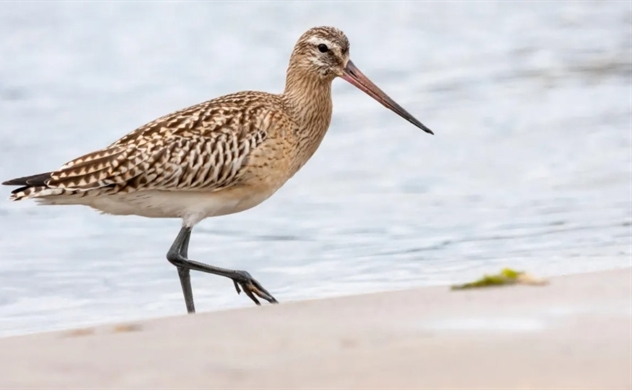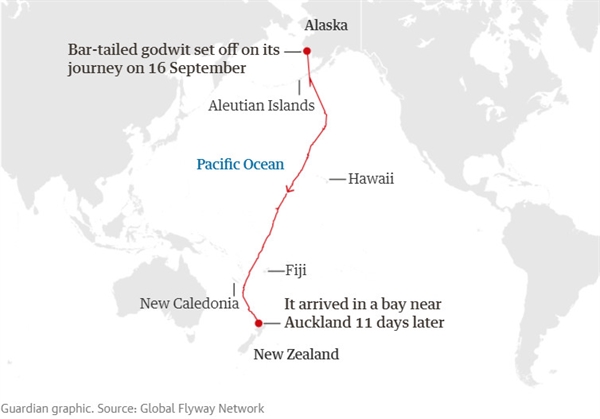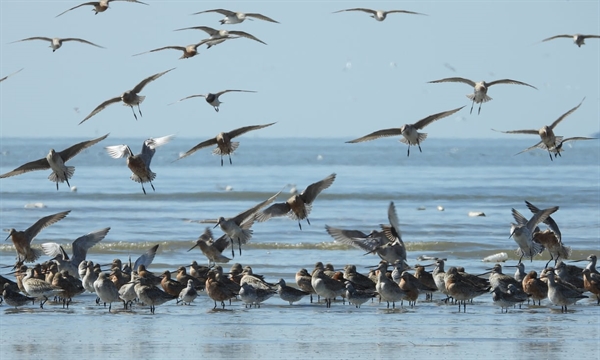'Jet fighter' godwit breaks world record for non-stop bird flight

Bar-tailed godwits shrink their internal organs to lighten the load on long flights. Photograph: Juan Carlos Martinez Salvadores/Alamy
A bird said to have the aerodynamic build of a “jet fighter” has been tracked flying more than 12,000km (7,500 miles) from Alaska to New Zealand, setting a new world record for avian non-stop flight.
The bar-tailed godwit set off from south-west Alaska on 16 September and arrived in a bay near Auckland 11 days later, having flown at speeds of up to 55mph.
The male bird, known as 4BBRW in reference to the blue, blue, red and white rings fitted on its legs, also had a 5gm satellite tag harnessed on its lower back to allow scientists to track its progress. It was one of four to leave together from the Alaskan mudflats where they had been feeding on clams and worms for two months.
The male bar-tailed godwit, whose standard weight is between 190gm and 400gm, can double in size before a long flight but is able to shrink its internal organs to lighten the load.
After leaving Alaska, the birds headed south over the Aleutian Islands and on to the Pacific Ocean. The journey is thought to have been prolonged by strong easterly winds, which pushed the group towards Australia.
The satellite recorded a point-to-point flight of 12,854km but the scientists believe that once rounding errors are taken into account the journey will have been around 12,200km. It is estimated that the total flight time was 224 hours. The previous longest recorded non-stop flight by a bird, of 11,680km, was recorded in 2007.
Dr Jesse Conklin, from the Global Flyway Network, a consortium of scientists studying epic migratory journeys, said: “They seem to have some capability of knowing where they are on the globe. We can’t really explain it but they seem to have an onboard map.
The bird flew non-stop for more than 7,500 miles from Alaska to New Zealand
 |
| Guardian graphic. Source: Global Flyway Network |
“They are flying over open ocean for days and days in the mid-Pacific; there is no land at all. Then they get to New Caledonia and Papua New Guinea where there are quite a few islands and, we might be anthropomorphising, but it really looks like they start spotting land and sort of think: ‘Oh, I need to start veering or I will miss New Zealand’.”
It is not certain but it is believed the birds do not sleep on the journey during which they flap their wings most of the time.
“They have an incredibly efficient fuel-to-energy rate,” Conklin said. “They have a lot of things going for them. They are designed like a jet fighter. Long, pointed wings and a really sleek design which gives them a lot of aerodynamic potential.”
The birds were among 20 caught and tagged by the Pūkorokoro Miranda Shorebird Centre, in the Firth of Thames, south-east of Auckland, in late 2019. They are expected to start the return flight in March, flying across Asia where they will feed for a month around the Yellow Sea, before returning to Alaska.
 |
| Bar-tailed godwits feeding on the Yalu River in Liaoning province, China. Photograph: Ding Li Yong/BirdLife International |
Scientists with the Global Flyway Network believe the route across the Pacific functions as an “ecological corridor” rather than a barrier to the birds; providing a wind-assisted passage relatively free of the risks of disease and predators.
“There are other birds that make similar-scale flights of say 10,000km but there are not a whole load of places in the world where it is necessary,” Conklin said. “So it is not necessarily that this is the only bird capable of it – but it is the only bird that needs to do it.”
News is under threat …
… just when we need it the most. Millions of readers around the world are flocking to the Guardian in search of honest, authoritative, fact-based reporting that can help them understand the biggest challenge we have faced in our lifetime. But at this crucial moment, news organisations are facing a cruel financial double blow: with fewer people able to leave their homes, and fewer news vendors in operation, we’re seeing a reduction in newspaper sales across the UK. Advertising revenue continues to fall steeply meanwhile as businesses feel the pinch. We need you to help fill the gap.
We believe every one of us deserves equal access to vital public service journalism. So, unlike many others, we made a different choice: to keep Guardian journalism open for all, regardless of where they live or what they can afford to pay. This would not be possible without financial contributions from those who can afford to pay, who now support our work from 180 countries around the world.
Reader financial support has meant we can keep investigating, disentangling and interrogating. It has protected our independence, which has never been so critical. We are so grateful.
We need your support so we can keep delivering quality journalism that’s open and independent. And that is here for the long term. Every reader contribution, however big or small, is so valuable.
Source: Guardian
Same category news
-
Tsubasa Suruga
-
Kenya Akama - Fumika Sato

 TIẾNG VIỆT
TIẾNG VIỆT 


















